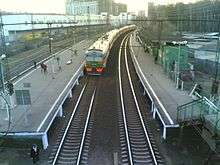Rizhsky suburban direction of Moscow Railway

The Rizhsky Suburban Direction of Moscow Railway (Russian: Рижское направление Московской железной дороги) is one of ten directions used for suburban railway connections between Moscow, Russia, and surrounding areas, mostly in Moscow Oblast. The Rizhsky Suburban Direction connects Moscow with the station in the northwest, in particular, with the towns of Krasnogorsk, Dedovsk, Istra, and Volokolamsk. The stations the direction serves are located in Moscow, as well as in Krasnogorsky, Istrinsky, Volokolamsky, and Shakhovskoy Districts of Moscow Oblast. Most of the suburban trains have their southeastern terminus at Moscow Rizhskaya railway station in Moscow, others commute from the Kursky Suburban Direction of Moscow Railway. In the northwestern direction, the suburban trains terminate at the stations of Pavshino, Nakhabino, Dedovsk, Novoiyerusalimskaya, Rumyantsevo, Volokolamsk, and Shakhovskaya.[1] The direction is served by the Moscow Railway.
The suburban direction follows the railway which connects Moscow with Riga via Rzhev and Velikiye Luki. It is electrified between Moscow and Shakhovskaya. Between Moscow and Volokolamsk, there are two tracks, west of Volokolamsk there is one track.[2] The distance between Rizhsky railway station and Shakhovskaya is 155 kilometres (96 mi).
History
The construction of the railway between Moscow and Vindava (Moscow-Vindava Railway) started in 1897. On June 30, 1901 the passenger traffic between Moscow and Volokolamsk was opened. Vindavsky railway station, currently Rizhsky railway station, was opened on September 11, 1901. The railway had only one track; the construction of the second track between Moscow and Volokolamsk only started in the 1950s.[3]
In 1945, the stretch between Moscow and Nakhabino was electrified. It was used by seventeen suburban trains per day in each direction. One of these trains continued to Lyublino, and sixteen others terminated at Rizhsky railway station. In 1954, the stretch to Guchkovo (currently Dedovsk) was electrified, and in 1955, the stretch to Novoiyerusalimskaya was electrified. In 1959, the direction was transferred to the Moscow Railway. In 1959, the electrification to Volokolamsk was completed, and for a long time Volokolamsk served as the end station of the direction. The traffic between Volokolamsk and Rzhev was performed by steam engine-led trains, later by diesel trains. In 1990, direct trains from Moscow to Shakhovskaya were launched, but the stretch between Volokolamsk and Shakhovskaya was only electrified by 1991, so that the trains between 1990 and 1991 were pulled by a diesel locomotive between Volokolamsk ans Shakhovskaya.[3]
In the 1930s, a side one-track stretch between Nakhabino 55°50′31″N 37°11′04″E / 55.842049°N 37.184386°E and Pavlovskaya Sloboda 55°48′18″N 37°05′15″E / 55.804905°N 37.08758°E was built. Although there was no direct connection between Moscow and Pavlovskaya Sloboda, it was served by the same locomotives as the main direction. In 1964 the stretch was electrified. In the 1990s, the military installations in Pavlovskaya Sloboda were disestablished, and the number of passengers dropped. Following the general trend, the Russian Railways decided to close down the stretch. It was closed down in 1996 and subsequently demolished.[3]
Stations
.jpg)
Following the standard notations in Russia, a railway stop below is called a station if it is a terminus or if it has a cargo terminal, and it is called a platform otherwise.
- Moscow Rizhskaya railway station, located in Moscow, Rizhskaya metro station 55°47′34″N 37°37′57″E / 55.792844°N 37.632594°E;
- Dmitrovskaya (platform), Moscow, Dmitrovskaya metro station;
- Grazhdanskaya (platform), Moscow;
- Krasny Baltiyets (platform), Moscow;
- Leningradskaya (platform), Moscow;
- Pokrovskoye-Streshnevo (platform), Moscow;
- Tushino (station), Moscow, Tushinskaya metro station 55°49′38″N 37°26′27″E / 55.827215°N 37.440784°E;
- Trikotazhnaya (platform), Moscow;
- Pavshino (station), Krasnogorsk;
- Krasnogorskaya (platform), Krasnogorsk;
- Opalikha (platform);
- Anikeyevka (platform);
- Nakhabino (station), Nakhabino;
- Malinovka (platform), Dedovsk;
- Dedovsk (station), Dedovsk;
- Miitovskaya (platform), Dedovsk;
- Snegiri (station);
- 50 km (platform);
- Manikhino I (station), connection to Moscow Big Ring Railway;
- Troitskaya (platform);
- Istra (platform), Istra;
- Novoiyerusalimskaya (station), Istra;
- Chekhovskaya (platform);
- Kholshchyoviki (station);
- 73 km (platform);
- Yadroshino (platform);
- Kursakovskaya (platform);
- Rumyantsevo (station);
- Novopetrovskaya (platform);
- Ustinovka (platform);
- 91 km (platform);
- Lesodolgorukovo (platform);
- Chismena (station);
- Matryonino (platform);
- Dubosekovo (platform);
- Volokolamsk (station), Volokolamsk;
- 133 km (platform);
- Blagoveshchenskoye (station);
- 141 km (platform);
- Bukholovo (platform);
- 149 km (platform);
- Shakhovskaya (station), Shakhovskaya, further connection to Rzhev 56°01′48″N 35°30′40″E / 56.030137°N 35.511235°E.
References
- ↑ Электрички Рижского вокзала (in Russian). Вокзал Инфо.Ру. Retrieved 20 October 2012.
- ↑ "Online railway map of Russia and the C.I.S.". Steam Engine IS. Retrieved 4 December 2016.
- 1 2 3 Старостин, Михаил; Александр Поздеев. "История пригородного движения с Рижского вокзала". Krasnogorsk City Portal. Retrieved 22 October 2012.